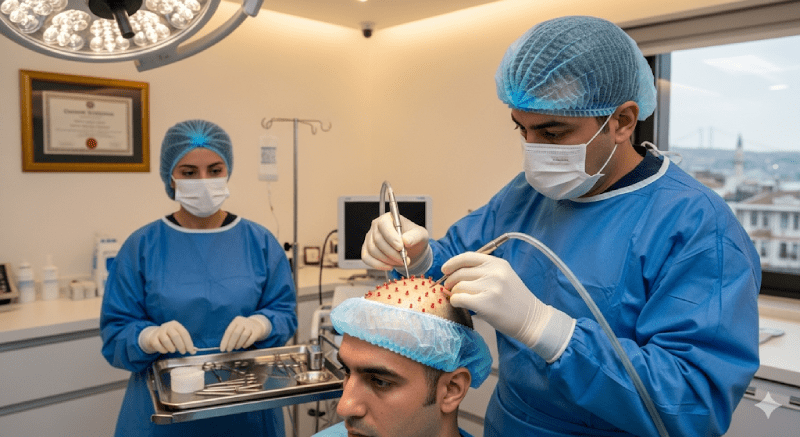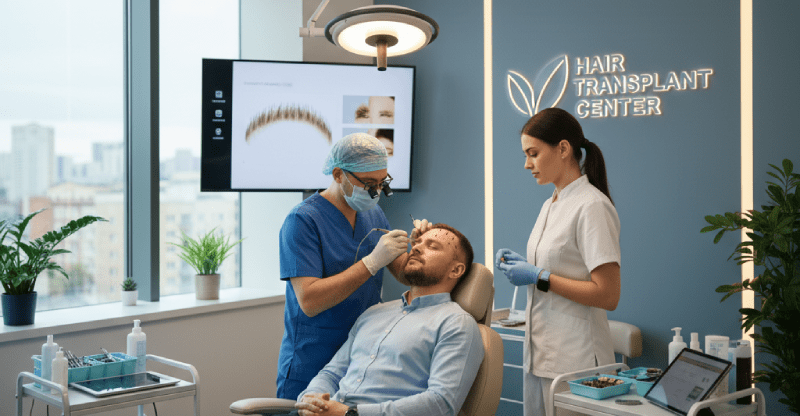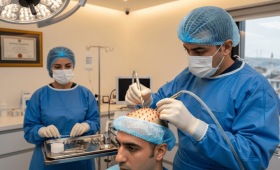What is Hair Transplantation?
Hair transplantation is a surgical procedure typically performed on individuals experiencing male-pattern baldness. It involves the transfer of hair follicles (grafts), which are genetically resistant to shedding, from the back of the head to bald or thinning areas. This procedure offers a permanent solution, allowing individuals to achieve fuller and more natural-looking hair. The transplanted hair follicles retain their shedding-resistant properties in their new location.
How Long Does a Hair Transplantation Operation Take?
The duration of the operation varies depending on the number of grafts to be transplanted and the technique used. On average, a hair transplantation operation can take 6 to 8 hours. This duration can change based on the surgeon’s and team’s experience, the patient’s head structure, and the speed of hair follicle extraction and transplantation. The operation is usually performed under local anesthesia, so the patient is awake during the procedure.
What Techniques are Used in Hair Transplantation?
The most common techniques used are FUE (Follicular Unit Extraction) and DHI (Direct Hair Implantation). In the FUE technique, hair follicles are extracted one by one with a special tool and then transplanted into pre-opened channels. In the DHI technique, hair follicles are implanted directly using a special tool called a Choi pen. Both techniques are minimally invasive and provide permanent results.
What Should Be Considered After a Hair Transplantation?
The first few days after the operation are very important. Alcohol and smoking should be avoided, strenuous sports should not be done, and the transplantation area should not be touched. The special lotions and shampoos recommended by the doctor should be used, and attention should be paid to the sleeping position. The first wash is usually performed at the clinic 2-3 days after the operation.
Who is a Candidate for Hair Transplantation?
Hair transplantation is generally applied to individuals over 18 years of age who have a sufficient donor area and do not have serious health issues. The most suitable candidates are those experiencing genetic hair loss or hair loss due to trauma or burns. The sufficiency of the donor area and the patient’s general health condition are evaluated during the preliminary examination.
Is Hair Transplantation a Permanent Solution?
Yes, hair transplantation is a permanent solution. The transplanted hair follicles are genetically resistant to shedding, so they retain their permanence for life in their new location. This procedure is one of the most effective and long-term solutions for hair loss problems.
How Are Hair Transplantation Prices Determined?
Prices vary depending on the number of grafts to be transplanted, the technique used, the clinic’s and surgeon’s experience, and the city and country where the operation is performed. Sometimes prices offered in package deals may also include post-operative care products and check-ups.

What is the Donor Area?
The donor area is the region from which hair follicles will be taken. The area between the two ears at the back of the head is generally preferred. The hairs in this region are genetically more resistant to testosterone and do not fall out. Therefore, they retain their permanence after transplantation.
Is Hair Transplantation a Painful Procedure?
The hair transplantation operation is performed under local anesthesia, so the patient does not feel any pain during the procedure. After the operation, a slight tingling or pain may be felt, but this can be easily controlled with painkillers recommended by the doctor.
Does Hair Transplantation Leave Scars?
Modern FUE and DHI techniques leave minimal scars because hair follicles are extracted one by one. These scars are usually dot-shaped, heal over time, and become almost invisible. The FUE technique, unlike the old FUT technique, does not leave a permanent and prominent scar.
When Do Transplanted Hairs Start to Grow?
The transplanted hairs start to grow within 2 to 3 months after the operation. It can take 6 to 12 months for them to achieve a completely natural look and become noticeable. This process can vary from person to person.
How Does the Healing Process Work After Hair Transplantation?
The post-operative healing process begins with swelling and redness in the first few days. Scabbing appears in the first week. Around the 10th day, these scabs fall off, and the hair becomes more visible. Full healing and the complete settling of the hair can take several weeks.
What is a Graft?
A graft is a term used in the hair transplantation procedure and refers to a piece of tissue containing one or more hair follicles. These tissues are taken from the donor area and transferred to the area to be transplanted. The number of hair strands within a graft can vary from 1 to 4.
What is the Best Season for Hair Transplantation?
Hair transplantation can be performed in any season. However, it is important to avoid sun exposure and protect against extreme hot or cold weather after the operation. Therefore, spring or autumn months may be more comfortable.
Can a Hair Transplant Fail?
The success of a hair transplant depends on many factors. The sufficiency of the donor area, the surgeon’s experience, the selection of the correct technique, and the patient’s attention to post-operative care directly affect success. When these factors are considered, the success rate is quite high.
When Can I Do Sports After a Hair Transplantation?
Light-paced walks can be started a few days after the operation. However, strenuous sports like heavy lifting or swimming and activities that increase sweating should be avoided for at least one month.
When Can Hair Be Washed After a Hair Transplantation?
The first wash is usually performed by specialists at the clinic 2 or 3 days after the operation. After the first wash, the patient can wash their hair themselves with the special shampoo and lotions recommended by the doctor as described.
Can Transplanted Hair Be Shaved?
The transplantation area should not be touched, not even with scissors, for the first month. Shaving with a machine can be done 6 months after the operation, but it might be safer to use scissors for the first year to ensure the transplanted hair is fully strong.
Can Hair Be Transplanted from the Beard or Chest Hair?
Yes, in patients with an insufficient donor area, beard or chest hair can be used as a donor. This method is called BHT (Body Hair Transplantation). Beard hair, being thicker and more durable, can provide better results.
When is Sexual Intercourse Possible After a Hair Transplantation?
It is recommended to avoid sexual intercourse for at least one week after the operation. This is important as it can increase blood pressure and sweating, which could harm the transplanted hair follicles.
What is the Most Suitable Age Range for Hair Transplantation?
Hair transplantation can generally be performed on individuals over 20 years of age. However, as the shedding process continues, specialists may consider around 25-30 years of age to be more suitable when the shedding has stabilized. This can eliminate the need for another transplantation in the future.
What Should Be Done Before a Hair Transplantation?
Before the operation, the use of alcohol, cigarettes, and blood-thinning medications should be stopped. It is important that the hair is clean and that comfortable clothes are worn on the day of the operation.
Is Hair Transplantation Done on Women?
Yes, hair transplantation can also be performed on women. Since the pattern of hair loss in women is different from men, DHI techniques such as unshaven transplantation are often preferred for women experiencing hair thinning.

Can I Travel Abroad After a Hair Transplantation?
Travel is possible immediately after the operation. However, it is important to be careful and follow the doctor’s recommendations for the first few days. It can be beneficial to get up and walk around frequently, especially during long flights, to support blood circulation.
When Do Transplanted Hairs Experience Shock Loss?
Between the 2nd and 8th weeks after the operation, a large portion of the transplanted hair falls out. This is called “shock loss” and is a natural part of the process. The shed hairs start to grow back after 3-4 months.
When Can a Second Hair Transplantation Be Performed?
If the desired result is not achieved after the first transplantation or if hair loss continues, a second operation can be performed. For a second transplant, the donor area must have fully healed and the existing hair must have settled. This period is usually at least 1 year after the first operation.
Is Beard and Mustache Transplantation Performed?
Yes, beard and mustache transplantation are performed similarly to hair transplantation. Hair follicles taken from the nape are usually transplanted into the thinning areas of the beard or mustache.
What are the Risks of Hair Transplantation?
As with any surgical procedure, hair transplantation also has some risks. These include infection, bleeding, numbness in the transplanted area, swelling, and scarring in the donor area. However, these risks are minimal with an experienced surgeon and a hygienic clinic.
How Should Nutrition Be After a Hair Transplantation?
After a hair transplant, a diet rich in protein, vitamins, and minerals accelerates the healing process. Foods containing B vitamins, zinc, iron, and vitamin C, in particular, help strengthen the hair follicles.
Hair Transplant Treatment in Mongolia
Mongolia is a country that offers treatments with uncertain success, with inadequate equipment of health institutions and failing health infrastructure system. It would be wrong to expect successful results from aesthetic treatments such as hair transplantation, as it is a country where basic treatments can hardly be provided. Because, as a result of your research, you can find only a few hair transplant clinics. Since their price is extremely high, if you choose, you will both accept unsuccessful treatments and pay very high prices.
Best Hair Transplant Clinics in the Mongolia
Located inUlaanbaatar, Skylar Mongolia, this clinic is a clinic you can choose. Since there are no successful hair transplant clinics in Mongolia, it is not possible to choose the best ones. However, if you are still planning to choose a hair transplant clinic in Mongolia, Skylar Mongolia will be the best choice. You should not forget that the prices are also very high.
Hair Transplantation Treatment Prices in Mongolia
You should know that the prices are very high as there are very few hair transplant clinics in Mongolia. However, you should know that the prices will not be very affordable since it is a country where it is difficult to receive treatment in health institutions in general.
Is Mongolia Successful in Hair Transplantation?
Unfortunately, it would not be correct to say that Mongolia is successful in hair transplant treatments, because there are very few clinics for hair transplants and they do not have sufficient equipment. This is a situation that often causes patients to receive treatment from different countries. There are places that are frequently preferred among these countries. You can also examine these places and choose a better country where you can get successful hair transplant treatments.
Best Country to Get Hair Transplant Treatment
Turkey is seen as the world leader in hair transplant treatments. Turkey is the best country that has proven its success in hair transplant treatments. At the same time, it is so economical that it cannot be compared with Mongolia. With the presence of many hair transplant clinics in Turkey, the fact that patients from many countries come to Turkey for hair transplant treatments has enabled surgeons to specialize in this branch. Of course, this is a situation that greatly affects the success rate of treatments.
Hair Transplant Treatment in Turkey
Turkey is a country that is considered the capital of the world in hair transplant treatments. The fact that first-class treatments are provided by leading surgeons, as well as having the best prices, explains why Turkey is preferred for treatment in many countries of the world. However, the high exchange rate in Turkey increases the purchasing power of foreign patients and facilitates access to treatments. You can also plan to get treatment in Turkey and do them at the best prices. You can call us for more detailed information. You should know that we are ready to answer all your questions about hair transplantation.
Hair Transplant Price in Turkey
Although the cost of getting treatment in Turkey is extremely affordable, we, as Cure Holiday, ensure that you get the best treatments from the most successful surgeons with our years of experience so that you can be treated at the most affordable prices. Unlike the pricing in many clinics, Unlimited number of grafts, One price!
At the same time, we offer services that will keep your extra expenses to a minimum with the package prices we have for accommodation, transportation and many examinations that need to be done in the hospital;
Our Treatment Price is 1,130€
Our Treatment Package Price is 1.500€
Services included in the package;
- Full-time transplant treatment in the hospital
- prp therapy
- Medicines
- shampoo set
- 2 days stay in a 5 star hotel
- Airport transfers
- PCR test
- nursing service
- Medication
Advantages of Getting Hair Transplant Treatment in Turkey
There can be many advantages of choosing Turkey for hair transplantation. You can have your treatments done with savings of up to 80%. The success of your treatments will be more assured than in many other countries. Because surgeons in Turkey have many years of experience in hair transplantation. However, the transplants to be made in the area where the front hairline starts will look quite natural.
Hair transplant treatments will consist of several-day sessions. Therefore, you will need to stay in Turkey for a few days and meet your basic needs. Thanks to the low cost of living in Turkey, you spend less money for your non-treatment needs compared to other countries.
Finally, if you want to turn your treatments into a holiday, it is possible for 12 months in Turkey. Thanks to its climate, it is a preferred destination for both summer and winter holidays. This makes it possible for patients to both take a vacation and receive treatment in Turkey whenever they wish.



